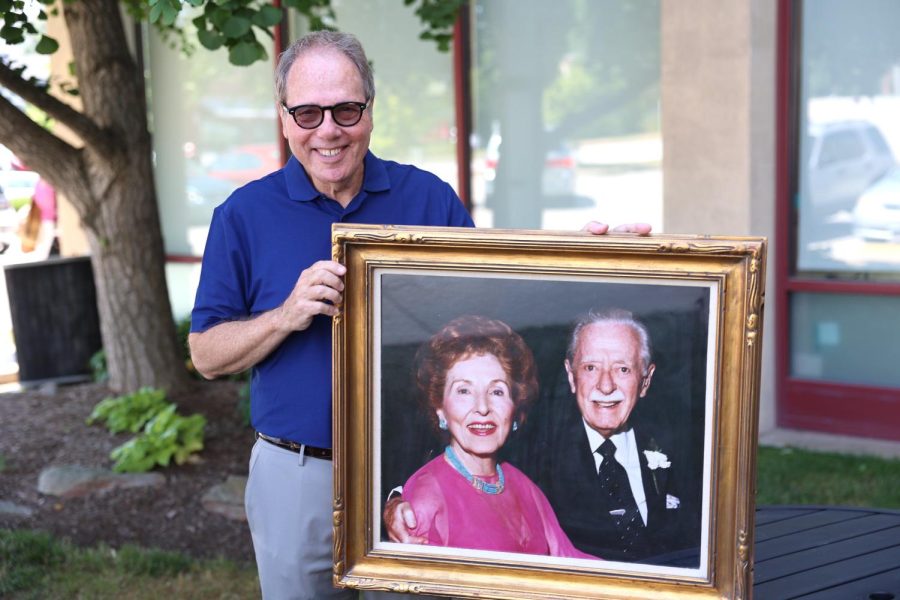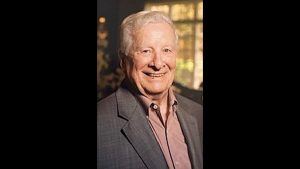Who were Henry & Gladys Crown?
Published October 25, 2022
The Henry and Gladys Crown Center for Senior Living is quickly evolving into a modern new facility, with Phase 1 scheduled to be completed early next year. Construction is in progress on a tower that will replace the aging Tallin Building and feature a new community center called Staenberg Commons on its first level.
The complex began 55 years ago as the Delcrest, named for the street it sits on just south of Delmar Boulevard. Two things won’t change after the renovation: The facility will continue to serve high quality housing to older adults, regardless of their financial situation; and it will continue to bear the name of a prominent Jewish philanthropic family.
Who were Henry and Gladys Crown?
Arie Krinsky arrived in America from Minsk in what was then called Belorussia in 1893, with a horse, cart and a belief in the American dream. He came in search of a better life for his family. Krinsky changed his last name to Crown and worked in a sweatshop. His son, Henry Krinsky, was born June 13, 1896, in Chicago, the third of seven children. He left school in the eighth grade at age 14. His parents were too poor to pay the 50 cents for his graduation photo.
ADVERTISEMENT
Like his father, Henry believed hard work would be his ticket out of poverty. It worked for the younger Crown, who started out working in low-wage jobs. He wrote letters to the presidents of 40 Chicago companies and asked for a job. He was hired by one. The head of a steel machine tool manufacturer was impressed by Henry’s imagination. Unfortunately, his youth was an obstacle in moving up to a more senior level.
So Henry Crown opened his own business, buying steel overruns at mill price and selling them at a discount. In 1919, he and his brothers Sol and Irving began Material Service Corp. The company was a huge success, and he expanded into other lines of business, including real estate. In fact, he was at one time the sole owner of the Empire State Building.
Crown tried to enlist in the military during World War I but was rejected because of poor eyesight. In World War II, he got in by memorizing the eye chart letters. He was assigned to the Corps of Engineers, which discovered their great good fortune in having someone so skilled at buying goods and services.
ADVERTISEMENT
The War Department quickly found their new procurement chief had a knack for saving large sums of money, reaching the hundreds of millions of dollars. After retiring from the military, Col. Henry Crown was frequently addressed as colonel, even in civilian life.
While Crown was serving during World War II, his wife, Bea, died of cancer. A few years later, he married Gladys Kay, who had been his personal secretary. Crown’s business acumen eventually led him to twice become chairman of General Dynamics, then based in St. Louis.
In 1966 the board exercised a merger option to buy Crown out. He immediately built a new company called Dolese and Shepherd and invested heavily in barges, tow trucks and railroads.
Crown also knew that the money General Dynamics borrowed to buy him out would ruin the company. It did, as the stock price plummeted, and he began buying more and more stock. He became the leading shareholder and was chairman again in 1970.
Caring for others
Henry Crown was brilliant as a businessman, but he had a caring, human side, said Randy Green, the great-nephew of Gladys Crown and a former member of the Crown Center board of directors.
“I was fortunate to spend time with him,” said Green, a St. Louis stockbroker. “He was inspiring, and I enjoyed his company. Everything he said, I learned something, and he wanted to share his experience with people whom he cared about, and I know he liked me. It was meaningful and valuable for me in my business career. He cared about people and cared about doing the right thing. He cared about what happened to the world.”
Green said he would often go on walks with Crown and talk about current events, business and anything the colonel was thinking about.
“Whatever was on his mind, he’d say to me,” Green said. “He trusted me and probably used that opportunity to vent a little bit. He like fishing, and I went fishing with him. He owned sports teams, but he wasn’t interested in sports. He was interested in Judaism.”
Gladys Crown was also committed to giving back through philanthropy, Green said. But her primary role was making sure Henry was well cared for.
“She was a very, very dynamic person,” he said. “She was never removed from his business. And when he went away to war, she ran the business. He left it in her hands. She took on a lot of the responsibility. Gladys made sure he wasn’t missing any meals. She didn’t care who he was talking to or meeting with. It could be a president. She’d say, ‘He’ll call back! Henry, you finish your lunch.’ ”
Delcrest becomes Crown Center
Henry Crown died in 1990, followed by Gladys one year later. She left a bequest that became the Henry and Gladys Crown Charitable Trust Fund. The Crowns gave hundreds of millions of dollars for grants in education, arts and culture, health care and community development.
The Green family was instrumental in the Delcrest being renamed the Gladys & Henry Crown Center for Senior Living during a large capital campaign in the mid-1990s. Although the Crowns were based in Chicago, they frequently traveled to St. Louis for General Dynamics board meetings. They also had relationships with other Jewish businesspeople in St. Louis, including former Blues hockey owner Sid Salomon.
Green said, “I was given the privilege when Mrs. Crown passed away, to being able to be a trustee for a certain amount of funds for charitable giving,” adding that the mission of Crown Center fits perfectly with Henry and Gladys’ philanthropic philosophy.
“One of the basic important tenets of Judaism is to take care of our parents, and Crown Center just expands that principle,” he said. “Not everyone has children to help take care of them. Crown Center serves that function.”
















